The Byronic Horseman: How BoJack Horseman Takes On the Classic ‘Byronic Hero’ Archetype
There goes our hero.
Back in the 1800s, they were published by a very famous Romantic figure; Manfred and Childe Harold’s Pilgrimage are but two of Lord Gordon Byron’s poetic scriptures in the boundless pages of his writing career. Featuring two protagonists who echoed Lord Byron’s own personal follies, the characters of Manfred and Childe Harold became the springboard for what would later be known as “The Byronic Hero” – an archetype unabashedly affected by their own shortcomings and flaws, while simultaneously retaining a thick air of self-obsession. This egotistical fixation traditionally calls for the downfall of the hero’s end; by death and stagnation of being – fated to whirl in a Sisyphean cycle of emotional relapse and prideful arrogance. Narcissism and self-loathing aren’t the typical traits one would think swim together in the proverbial personality pool, yet the romanticized, bigger-than-life identity that these deeply flawed individuals create within their minds seem to be ironically rooted in a deluded sense of grandeur.
The Byronic Hero’s constant lamenting for their own behavior serves as a convenient indulgence for their sins, rather than a starting point from where they can learn and grow – thus creating a multifaceted manipulation technique to purposefully veer themselves away from their needed development as individuals. Should there be one setting on Earth that pampers narcissists, toxic behavior and stagnation of personal growth altogether, Hollywood would be it – or in this case, rather, “Hollywoo.” The Byronic Hero holds no biases on gender, ethnicity, age – or animal. The alcoholic, troubled, jaded BoJack Horseman is no exception. The Byronic Hero is not a role reserved for Romantic Era individuals – on the contrary, this is the only role BoJack has ever literally stayed true to. Constantly trying to live up to the former glory of his golden celebrity years, BoJack’s inability to mature from his 20’s has caused his ego to inflate further into a self-entitled, self-centric state – and, much like Manfred and Childe Harold, these qualities are the very cause of his repeated (emotional or physical) doom, which has spurred the vast majority of conflicts for BoJack over the course of the show. BoJack Horseman embodies the classic Byronic hero through his taboo sexual escapades, the romanticization of his own sadness, and ultimate inability to grow as a person.

Lord Byron – categorized as, “mad, bad, and dangerous to know,” – made an infamously “bad” decision when he formed a sexual relationship with his half-sister. His incestuous blunder caused him the scorn of many U.K. citizens. The entire ordeal preyed on his conscience until it soon thereafter bled into his work; thus resulting in the strife of Manfred and Childe Harold, whose troubles resulted from lusting after their respective sisters. There remains to be a pattern of comfort in finding love within the family (literally) for the typical Byronic Hero – with BoJack’s case being no different. Within the realm of his famous sitcom series, Horsin’ Around, BoJack plays the parent of three orphans, including one “Sabrina,” played by future pop-star and celebrity icon, Sarah Lynn.
Years after the series’ end, BoJack is constantly looking to the past for comfort from his unfulfilling, lonely life, in the “has-been” phase of stardom. Sarah Lynn, now 30, appears on BoJack’s doorstep in the episode, “Prickly-Muffin” (S1E3) and asks to stay with him for an undetermined amount of time. Excited by the opportunity to live out a portion of his fictional family again, BoJack soon discovers there is more to his emotions than just the happy aspect of feeling as if he is reliving past years. “I’m not trying to play out some weird, sick Dad Fantasy,” BoJack asserts soon before sleeping with Sarah Lynn. The pseudo-daughter he knew for nearly all her life was now an object of sexual desire; a “P.R. Disaster” in waiting. Not dissimilar to Byron’s own “P.R. Disaster,” BoJack’s desensitization to both family and loved ones with the addition of his attention-starved nature makes him an easy candidate for one who might latch onto pre-established, “obligated” relationships – such as a daughter, sister, or other familial ties, to fill in the void of any other relationship. Part of BoJack’s self-loathing may stem from the hypothesis that no one could ever love him without the obligation to; thus leading him to the incestuous similarities of a Byronic Hero – and also toward the romanticization of his own sadness.
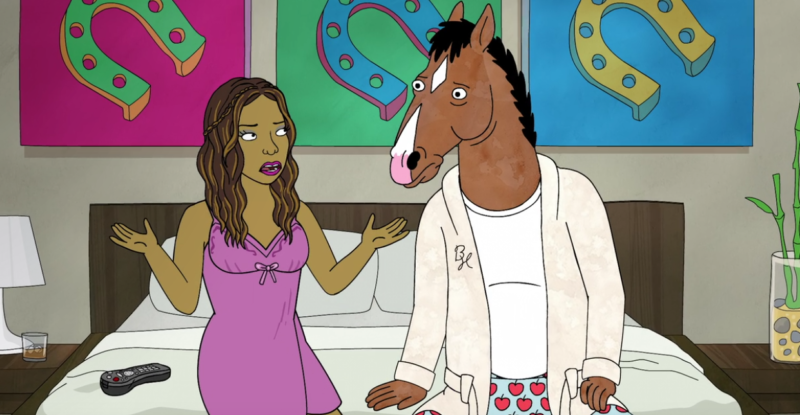
In “It’s You” (S3E10) BoJack’s associate, Ana, tells him not to “fetishize his own sadness.” In the true spirit of the Byronic Hero, BoJack doesn’t critically think about what that means, and rather, regurgitates that advice to others in order to trick himself, and his peers, into thinking he’s wiser than he is. Later, in “The Old Sugarman Place” (S4E2) BoJack takes an aimless journey away from L.A. and views the various sights and sounds of nature on his travels – eventually winding up at his old summer home in Michigan. This expedition to simultaneously run from his problems and gain clarity through isolation and travel echoes the entire narrative of Childe Harold’s Pilgrimage, wherein BoJack spends a year and a half alone in his run-down cabin. During this time, a fly named Eddie helps him rebuild this house, and inquires about who “BoJack Horseman” is – to which BoJack replies:
“Who’s BoJack Horseman!? He’s a very famous TV and film star! Or he was, yeah, before he gave it all up, for a life of quiet anonymity. Where is he? Nobody knows. Perhaps in a small town like this one. Perhaps he’s even… in this very room.”
This is said as he gazes almost mock-melancholically out of a window. This gesture of “self-reflection” is placed within his created narrative, wherein he is a tragic “lone-wolf,” in a world that never understood him when the reality is that he simply can’t face his own inner problems in order to be proactive in solving the outside ones around him. Stanza 4, Canto III in Childe Harold’s Pilgrimage contains a similar narrative of Childe Harold’s mindset when it came to his own emotions;
“He who grown aged in this world of woe,
In deeds, not years, piercing the depths of life,
So that no wonder awaits him; nor below
Can love, or sorrow, fame, ambition, strife,
Cut to his heart again with the keen knife
Of silent, sharp endurance: he can tell
Why thought seeks refuge in lone caves, yet rife
With airy images, and shapes which dwell
Still unmpair’d, through old, in the soul’s haunted cell.” (37-45, p.623)
The stanza discusses how no emotion or thing (including fame) can affect one so blue and aged, and in this particular case, bound to a “haunted cell,” easily relatable to BoJack’s cabin, or his (metaphorically partially glass) home in L.A. This stanza doesn’t simply tell the audience about Childe Harold, though, as Lord Byron is revealed to be Childe Harold autobiographically. Instead of working passed his own issues, Byron stands at the metaphorical window with BoJack, and tries to captivate an audience through a “fetishization” of his sadness and woe.
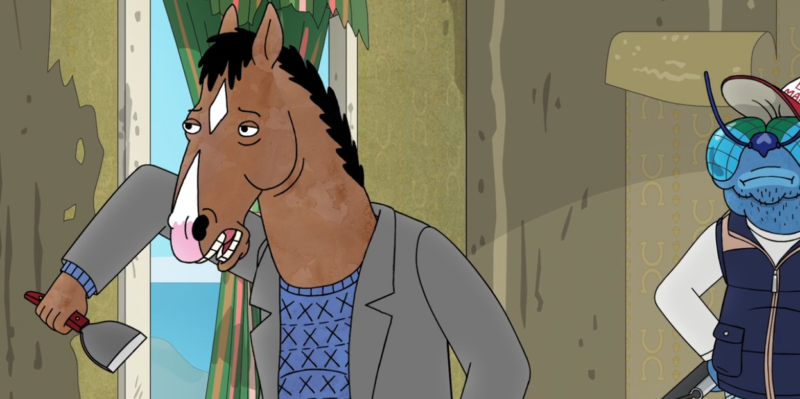
All this, and yet the Byronic Hero isn’t necessarily oblivious; Manfred, Childe Harold, and BoJack are all aware of the sins they’ve committed – in this, there seems to be a sense of knowing how to right what they’ve wronged, turn their lives around, and begin again. However, the one deep-rooted trait that all Byronic Heroes share is pride – and it is detrimental to growth; making these characters opt for giving up over taking the difficult actions toward healing their own lives. Highlighting the entire moral of the play, Manfred’s final line before his death proclaims, “Old man! ‘Tis not so difficult to die.” (Line 151, p.672), emphasizing how taking responsibility for one’s own life is a much more arduous task than simply giving up – so much so, that Manfred chooses the ease of death over it.
All in the black-and-white nature of a Byronic Hero to feel as though they have no choice but to die, BoJack Horseman’s visual storytelling in “It’s You” tells the age-old tale of a protagonist who is handed advice and help, but purposefully does not take it. When BoJack crashes his car into his own pool at the Oscar Nomination party, we are given a frontal view to BoJack at the base of the water. We can recall, here, Ana Spanakopita’s advice to BoJack about drowning; that when she was in a position where, “it was dark and cold,” and she “couldn’t tell which way was up,” she opened her mouth and followed the air bubbles to the surface. This is a metaphorical statement for being able to “open one’s mouth” or “be open” about the things keeping one “drowning.” In this instance, BoJack is in clear, shallow water. He views the bubbles drifting upward toward the surface, yet still chooses to close his eyes and let the water take him. This is the choice of a Byronic Hero – their suffering is not one of circumstance. It is one of a decision, and blame on anything aside from themselves and their own actions – despite the knowledge of their flaws and cyclical lamenting for their own self-sabotaging nature.
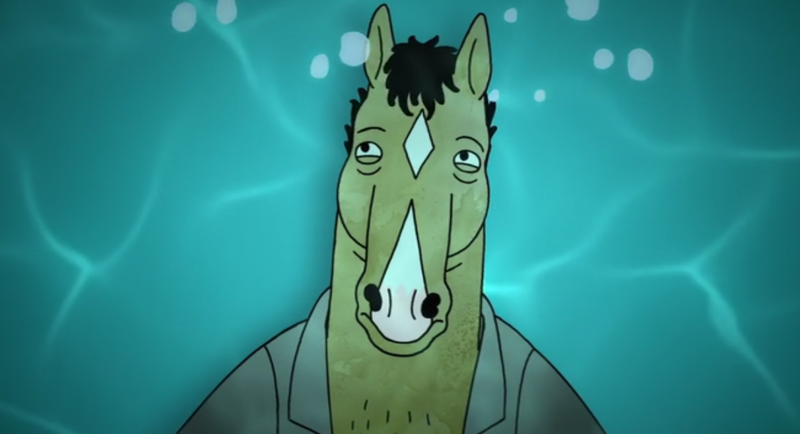
Throughout BoJack Horseman’s latest season (S5), we see BoJack mimic the repetitive, toxic behaviors of his character, “Filbert” — a mirror to himself, and his actions (similarly, of course, to how Lord Byron’s characters reflect his own behaviors.) When considering the dark ending of the season, the thought occurs: is BoJack — a Byronic Hero — doomed like all the others? Manfred meets his fate at the end of his tale, and Childe Harold – who we know doubles as a pseudo-Lord Byron himself – died with him. An optimistic light is placed in BoJack’s narrative when we see him go to rehab, though, so there is a possibility that BoJack may defeat this archetype, and prove that he is not, in fact, caught in a cycle of himself.
However, it is a conceivable foreshadowing wonder in itself that the horse dies at the very end of Horsin’ Around.
Works Cited:
- Greenblatt, Stephen, and M. H. Abrams. The Norton Anthology of English Literature. W.W. Norton, 2012. (Childe Harold’s Pilgrimage, Manfred)
- Bob-Waksberg, Raphael. “Prickly-Muffin.” BoJack Horseman, Season 1, Episode 3, Netflix, 22 Aug. 2014. (S1E3)
- Santamaria, Vera. “It’s You.” BoJack Horseman, Season 3, Episode 10, Netflix, 22 July 2016. (S3E10)
- Purdy, Kate. “The Old Sugarman Place.” BoJack Horseman, Season 4, Episode 2, Netflix, 8 Sept. 2017. (S4E2)

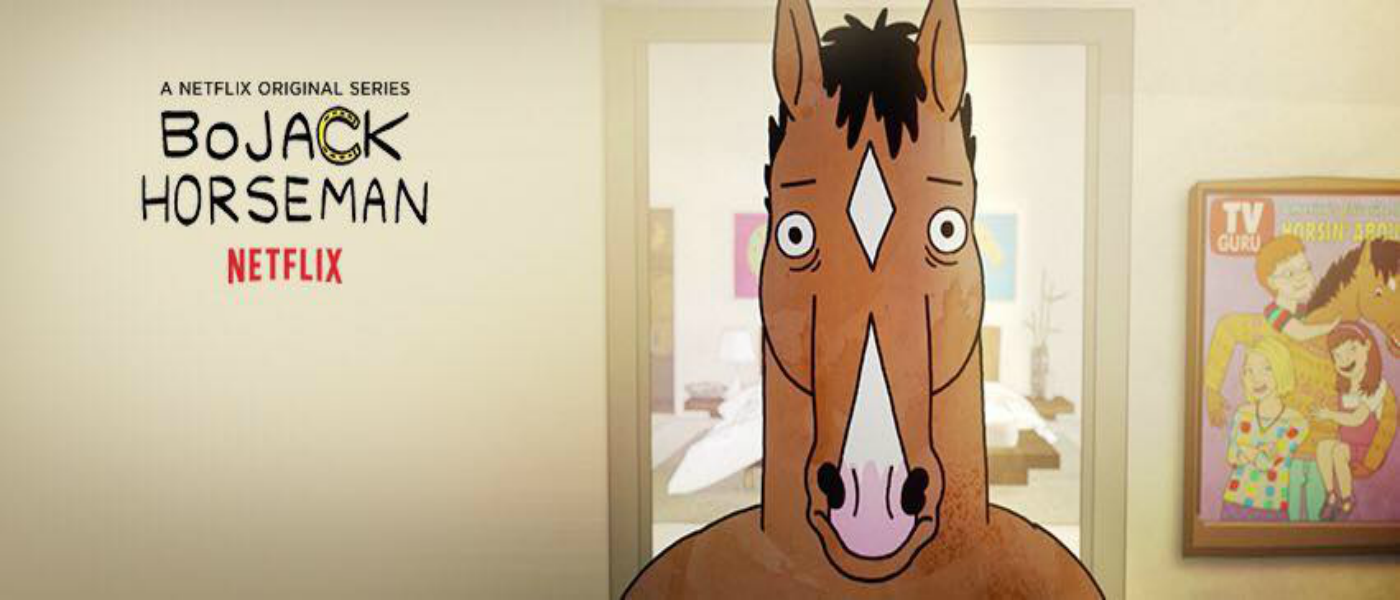


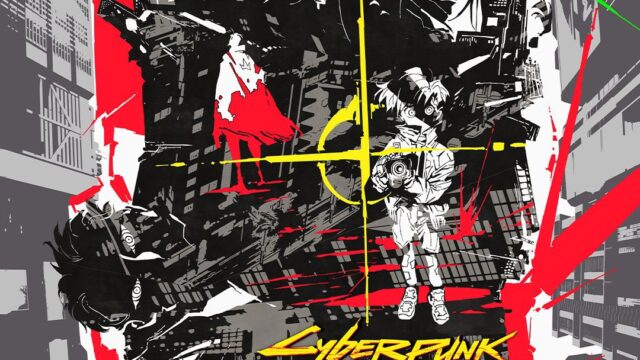













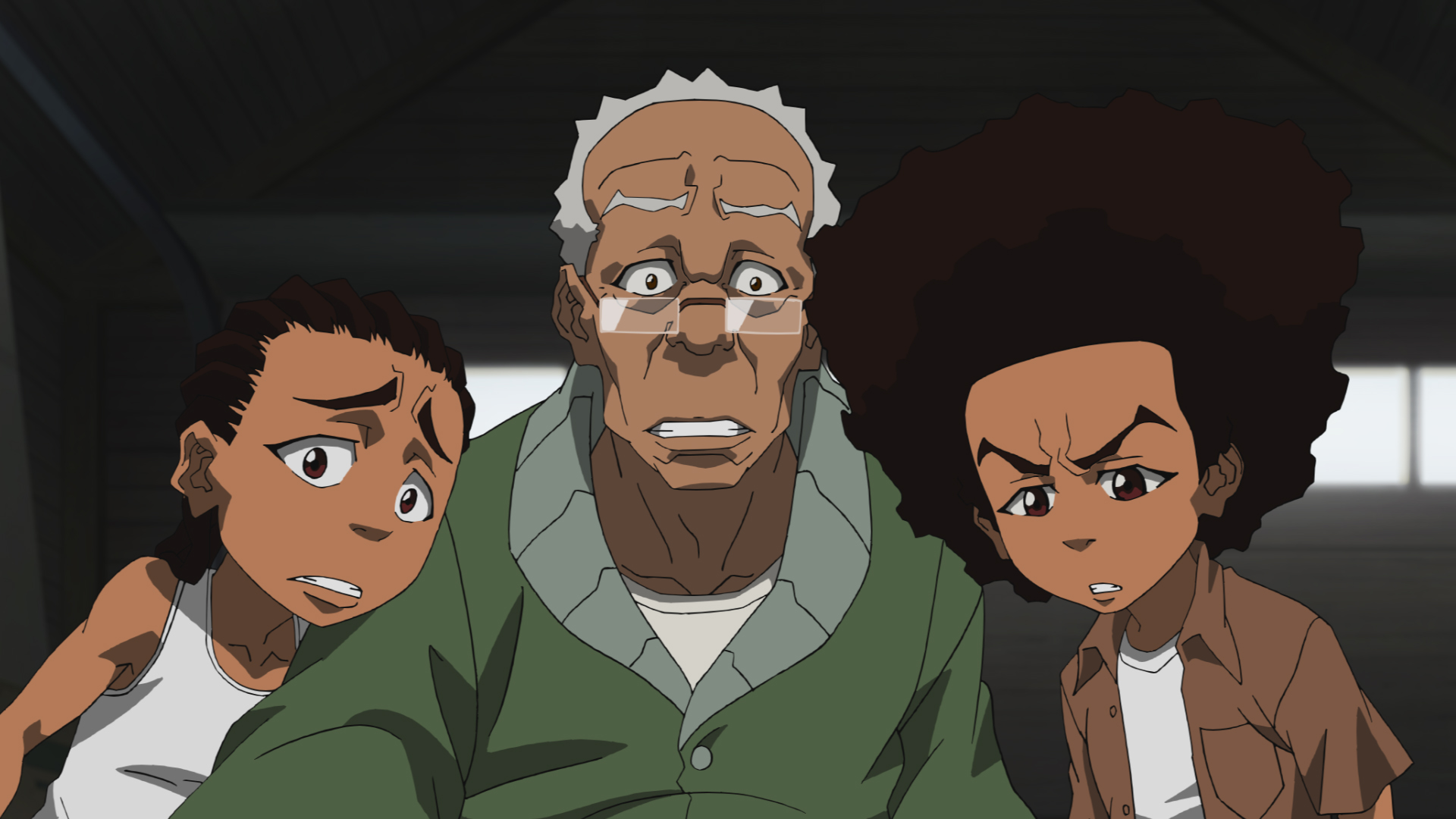


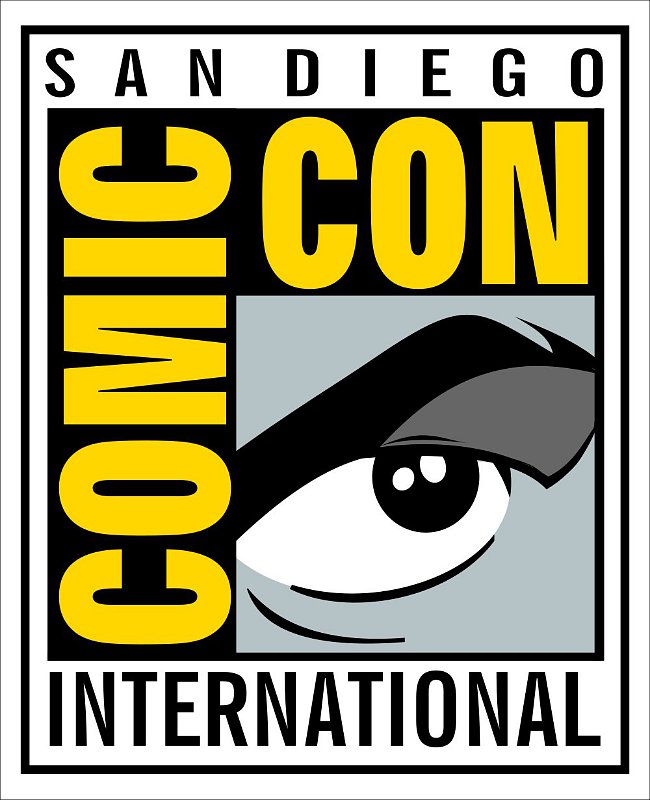


"There are also other characters that come and go (also owned by the Warner Bros. Discovery conglomerate media company)."
Huh. Is that just referring to other characters from the show itself, or is this implying that the new season is going to have cameos from other WBD IPs